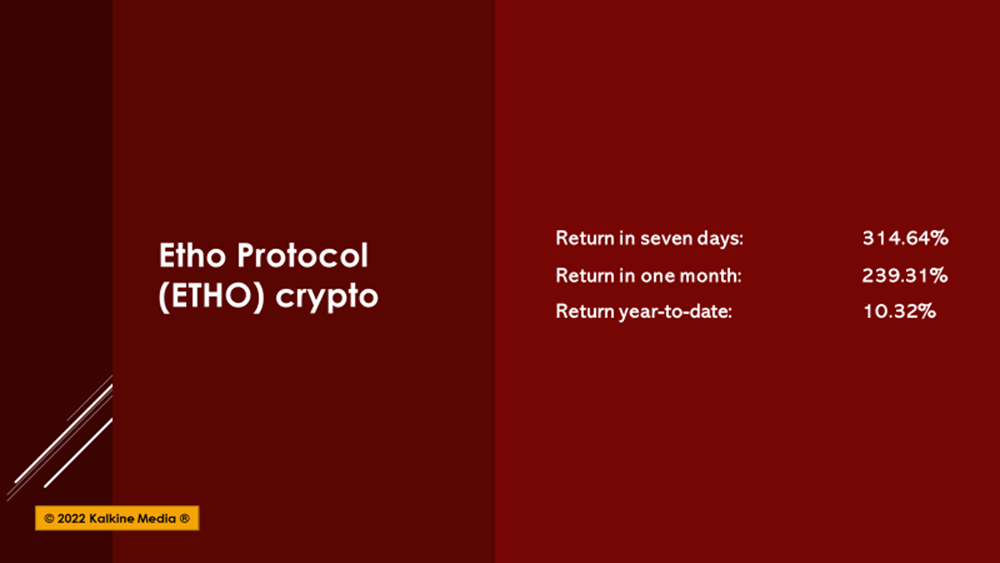Highlights
- The Etho Protocol (ETHO) blockchain runs on a proof-of-work consensus mechanism providing IPFS storage via master nodes.
- It is forked from Ethereum and has the same properties as Ethereum, such as block time, mining algorithm, and EVM.
- ETHO’s current circulating supply is 5.76 million, and the total supply is 83.59 million.
The Etho Protocol (ETHO) has been catching investors’ interest recently. On Monday, its trading volume saw an extraordinary leap of 3182.00% to US$9.2 million.
Likewise, the ETHO token price increased by 317.90% to US$0.07845 at 4:57 am ET.
The Etho blockchain runs on a proof-of-work consensus mechanism that provides IPFS (Inter Planetary File System) storage via its master nodes. The IPFS is a protocol and peer-to-peer network for sharing and storing data in a distributed file system.
What is Etho Protocol?
The Etho Protocol integrates IPFS in its master nodes and contracts stored on the blockchain. The master nodes are the basic structure of Etho Protocol and could be deployed by anyone. According to its official blog, these nodes are like mini data centers deployed by people worldwide to provide decentralized and immutable storage solutions.
The Protocol was developed to implement a decentralized storage hosting platform using a fork on Ethereum. It has the same properties as Ethereum, such as block time, mining algorithm, and EVM.
Also Read: Why is Trust Wallet token (TWT) rising?
One can create tokens and NFTs and deploy DApps and other DeFi projects on Etho at a lower cost than ETH, just like on Ethereum. However, the difference between the two is the use of IPFS as Etho Protocol runs its own IPFS storage network.
Etho has three nodes: Masternodes, Service Nodes and Gateway Nodes. These nodes are rewarded for staking ETHO and for their network contributions.
Also Read: Solana (SOL) crypto drops after outage; know more here
It is a 100% community-based volunteer project that aims to disrupt how information is shared and controlled on the internet. It wants to decentralize it completely by involving a node-based governance system, a PoW blockchain layer with smart contracts and providing other utility services. It allows censorship-resistant website hosting through its node network and bandwidth.
The blockchain can store limited data, but one must offload the data into a central grid to store more data. For this purpose, the Protocol uses master nodes, or storage nodes, synchronized with the blockchain. The data remains secure if one of the nodes goes down since the process is replicated and the data is stored on several nodes.
Also Read: Why is Celsius (CEL) crypto falling? Data Source: coinmarketcap.com
Data Source: coinmarketcap.com
Also Read: Why is EVM blockchain Velas (VLX) rising? know more about it here
Roadmap:
The Protocol targets wider IPFS Network Integration during Phase 4 development (from 2021-to 2022). It will allow broader access to the Protocol by NFT marketplaces and help onboard other Etho Protocol services. Under Phase 5 (2022-25), it plans to be the premier network for decentralized storage, NFT, and DeFi Application deployment
Also Read: What is RadioShack (RADIO) crypto and why is it rising?
ETHO token:
The ETHO token is the native coin of the Etho blockchain and is traded on several crypto exchanges such as Kucoin, Probit Global, Mercatox, and STEX. Its current market capitalization is US$452000, the circulating supply is 5.76 million, and the total supply is 83.59 million.
Also Read: What is Reserve Rights (RSR) crypto? Know price & performance
Bottom line:
The Etho Protocol wants to offer a fully decentralized storage solution. It has a software development kit (SDK) that allows developers to create storage contracts on Etho Protocol.
However, regardless of the benefits crypto projects offer, one must exercise caution before investing in the market, given the unregulated nature of the market and the risks of scams.
Risk Disclosure: Trading in cryptocurrencies involves high risks including the risk of losing some, or all, of your investment amount, and may not be suitable for all investors. Prices of cryptocurrencies are extremely volatile and may be affected by external factors such as financial, regulatory, or political events. The laws that apply to crypto products (and how a particular crypto product is regulated) may change. Before deciding to trade in financial instrument or cryptocurrencies you should be fully informed of the risks and costs associated with trading in the financial markets, carefully consider your investment objectives, level of experience, and risk appetite, and seek professional advice where needed. Kalkine Media cannot and does not represent or guarantee that any of the information/data available here is accurate, reliable, current, complete or appropriate for your needs. Kalkine Media will not accept liability for any loss or damage as a result of your trading or your reliance on the information shared on this website.






